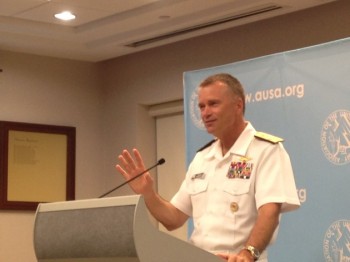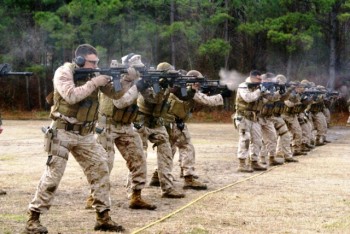Part of our Sacred Cow series, originally posted at USNI Blog.
Speaking at the Association of the United States Army on the 12th, Admiral James Winnefeld, the Vice Chairman of the Joint Chiefs of Staff, told the audience that in future ground wars the tempo will be “shorter, faster-paced and much harder” because America’s adversaries will work to create a “fog of war.” Thus, the Admiral suggested that the Army “place more emphasis on the growth industry…of protecting American citizens abroad” in order to adapt to the fluid geostrategic environment.

VCJCS Admiral James Winnefeld speaking at the Association of the United States Army on September 12th.
Indeed, since the sequestration went into effect in March, many defense experts have been debating what the future may hold for the Army, the Marine Corps and the Special Operations Command (SOCOM). Whatever their respective views may be on the utility of landpower in future wars, all seem to agree on one thing: that in the sequestration era, the ground components must fight leaner and smarter.
For John R. Deni, a research professor at the U.S. Army War College’s Strategic Studies Institute, the answer seems to lie in the “Army-led military-to-military activities” which may provide stability in politically volatile regions “if only because most military forces around the globe are army-centric.”
Others beg to differ. Generals James Amos and Raymond Odierno and Admiral William McRaven seem to second Admiral Winnefeld’s claim when they argue that today “the need to conduct large-scale aid and consequence management missions, both within the United States and internationally, is certain to grow.” General James Amos, the Marine Corps Commandant, also recently echoes this view when he advocates a lighter but mobile Marine Corps because he believes tomorrow’s conflicts will likely involve “violent extremism, battles for influence, disruptive societal transitions, natural disaster, extremist messages and manipulative politics.”
However, if the United States Armed Forces is truly concerned about raising a cost-efficient and versatile ground force, it can merge the Army, the SOCOM and the Marine Corps into one unified service branch. This idea is not new. As far back as 1994, the late Colonel David Hackworth advocated the merger of the Army and the Marine Corps because their missions seemed to overlap. He went so far as to claim that the Department of Defense (DoD) could save “around $20 billion a year.” Nevertheless, absent in Hackworth’s column was a coherent blueprint for how the DoD could effectively unify its ground components into a cohesive service because Hackworth did not flesh out his strategic vision for what 21st Century wars may look like.
Which raises a very salient question as to what America’s strategic priorities should be. In a perceptive op-ed, Mark Fitzgerald, David Deptula and Gian P. Gentile aver that the United States must choose to go to “war as a last resort and not a policy option of first choice.” To this must be added another imperative. The United States Armed Forces must prioritize homeland defense as its primary mission and rethink the mistaken belief that the United States can somehow secure its interests through “lengthy military occupations of foreign lands.”
Thus, this newly merged service must redirect its focus towards countering cyber warfare and CBRNe (Chemical, Biological, Radiation, Nuclear and explosives) attacks and should work towards bolstering its counterterrorism (CT) capabilities. This is because, due to the convergence of the global community, the United States may be vulnerable to attacks from within by homegrown terrorists and drug cartels—all of which may wreak havoc and may even cripple America’s domestic infrastructures.
Reorientation of its mission focus may also require that the new service reconfigure its size. After all, as Chairman of the Joint Chiefs of Staff, General Martin Dempsey wrote in Foreign Affairs, “Washington should remember that the size of the armed forces is not the most telling metric of their strength.” One solution is to adopt the so-called “Macgregor Transformation Model (MTM)” centered around the combat group concept which may reduce the strength of the new service “yet in the end produce a force that has greater combat capability…[and] more sustainable.” This model may provide the United States with a deployable fire brigade in the event of a national emergency or an international crisis. Already, the bases from which to adopt this viable model exist in the form of Army brigade combat teams (BCTs) and Marine Air-Ground Task Forces (MAGTFs) of various sizes.
Should the United States decide that it needs to project its hard power abroad to guard its interests, it could deploy the Special Operations Forces (SOF) components of the new service in tandem with UAV (Unmanned Aerial Vehicles) to selectively target and neutralize potential threats. While the SOF and UAV surgical raids should not be viewed as substitutes for deft diplomacy, they can provide cheaper and selective power projection capabilities. Moreover, doing so could minimize the risks inherent in power projection and anti-access/area denial (A2/AD) missions which may potentially mire the United States in messy and protracted conflicts.

Marines from MARSOC honing their rifle marksmanship skills. Photo by MARSOC Public Affairs
Last but not least, this new service could buttress interoperability and capabilities of allied forces around the globe through military-to-military exchanges. Although Deni was referring specifically to the Army-led initiatives when he suggested this, he may be correct that military-to-military engagements may help to promote America’s image abroad as a trusted guarantor of peace. But even more important, such activities may “mean fewer American boots on the ground.” However, implementing what the retired Marine General James Mattis refers to as the “proxy strategy” may be a better means by which the United States could “lead from behind.” Under this arrangement, while “America’s general visibility would decline,” its allies and proxies would police the trouble spots on its behalf.
Contrary to what many in the defense establishment believe, the austerity measures wrought by the sequestration have not been entirely negative. If anything, this perceived “crisis” has provided the much-needed impetus for innovative approaches to national defense. The proposed merger of the ground forces may provide the United States with most cost-effective and versatile service branch to defend the homeland and safeguard its interests abroad.
